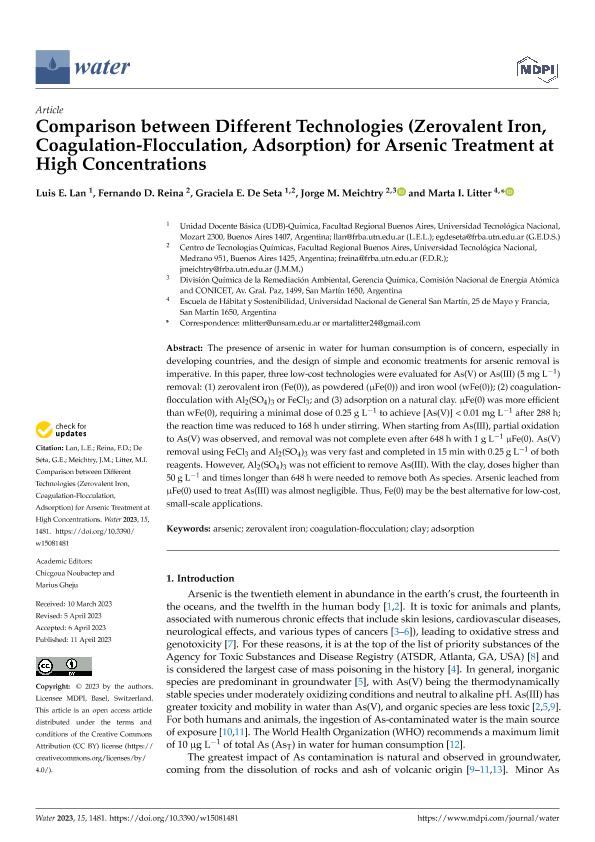Artículo
Comparison between Different Technologies (Zerovalent Iron, Coagulation-Flocculation, Adsorption) for Arsenic Treatment at High Concentrations
Lan, Luis E.; Reina, Fernando Damián; De Seta, Graciela E.; Meichtry, Jorge Martin ; Litter, Marta Irene
; Litter, Marta Irene
 ; Litter, Marta Irene
; Litter, Marta Irene
Fecha de publicación:
04/2023
Editorial:
MDPI
Revista:
Water
ISSN:
2073-4441
Idioma:
Inglés
Tipo de recurso:
Artículo publicado
Clasificación temática:
Resumen
The presence of arsenic in water for human consumption is of concern, especially in developing countries, and the design of simple and economic treatments for arsenic removal is imperative. In this paper, three low-cost technologies were evaluated for As(V) or As(III) (5 mg L−1) removal: (1) zerovalent iron (Fe(0)), as powdered (μFe(0)) and iron wool (wFe(0)); (2) coagulation-flocculation with Al2(SO4)3 or FeCl3; and (3) adsorption on a natural clay. μFe(0) was more efficient than wFe(0), requiring a minimal dose of 0.25 g L−1 to achieve [As(V)] < 0.01 mg L−1 after 288 h; the reaction time was reduced to 168 h under stirring. When starting from As(III), partial oxidation to As(V) was observed, and removal was not complete even after 648 h with 1 g L−1 μFe(0). As(V) removal using FeCl3 and Al2(SO4)3 was very fast and completed in 15 min with 0.25 g L−1 of both reagents. However, Al2(SO4)3 was not efficient to remove As(III). With the clay, doses higher than 50 g L−1 and times longer than 648 h were needed to remove both As species. Arsenic leached from μFe(0) used to treat As(III) was almost negligible. Thus, Fe(0) may be the best alternative for low-cost, small-scale applications.
Palabras clave:
ADSORPTION
,
ARSENIC
,
CLAY
,
COAGULATION-FLOCCULATION
,
ZEROVALENT IRON
Archivos asociados
Licencia
Identificadores
Colecciones
Articulos(SEDE CENTRAL)
Articulos de SEDE CENTRAL
Articulos de SEDE CENTRAL
Citación
Lan, Luis E.; Reina, Fernando Damián; De Seta, Graciela E.; Meichtry, Jorge Martin; Litter, Marta Irene; Comparison between Different Technologies (Zerovalent Iron, Coagulation-Flocculation, Adsorption) for Arsenic Treatment at High Concentrations; MDPI; Water; 15; 8; 4-2023; 1-19
Compartir
Altmétricas



